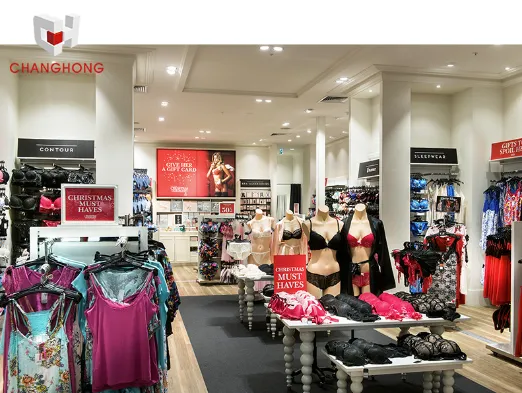- 150 میٹر جنوب کی طرف، ویسٹ ڈنگ وی روڈ، نانلو ولیج، چانگن ٹاؤن، گاؤ چینگ ایریا، شیجیازوانگ، ہیبی، چین
- monica@foundryasia.com
جولائی . 21, 2025 13:46 فہرست پر واپس جائیں۔
How to Build the Perfect Clothes Shop Display and Fixtures That Sell
In fashion retail, the way you display clothing can be just as important as the clothing itself. Customers don’t just want to shop—they want an experience. And that experience starts with a smart, attractive cloth display that brings your brand to life, draws attention to your products, and makes browsing easy and enjoyable.
Whether you’re setting up a boutique, running a fast-fashion outlet, or launching a lifestyle concept store, your clothes shop display and supporting clothes shop fixtures can either enhance your brand’s value—or kill the vibe entirely.
Here’s how to create a display that does more than look good—it drives foot traffic, encourages interaction, and turns browsers into buyers.

Why Cloth Display Matters
A well-thought-out cloth display isn’t just about aesthetics. It helps:
Organize merchandise so shoppers can find what they want quickly
Tell a visual story (e.g., seasonal collections, color themes)
Maximize floor space without overwhelming the customer
Highlight new arrivals or promotions
Reinforce your brand personality
Clothing is tactile. Shoppers want to touch, hold, and try it on. A good display encourages that interaction—without creating clutter or confusion.
Core Elements of a Clothes Shop Display
Your clothes shop display should be functional, flexible, and on-brand. It usually includes:
1. Wall Displays and Hanging Rails
Great for maximizing vertical space
Perfect for outerwear, denim, or color-blocked themes
Can be fixed or adjustable (floating rails, slatwalls, pegboards)
2. Freestanding Garment Racks
Easy to reposition for new layouts or seasonal changes
Useful for center-floor displays, sale sections, or capsule collections
3. Tiered Tables or Feature Platforms
Best for folded items like knitwear, jeans, or graphic tees
Combine with accessories to create “complete look” zones
4. Mannequins and Busts
Must-haves for showcasing styling inspiration or premium pieces
Should reflect your brand’s target audience in size, posture, and styling
5. Display Cubes and Modular Shelves
Stackable and easy to customize
Ideal for mixing folded garments with shoes, bags, or signage
Choosing the Right Clothes Shop Fixture
Fixtures are the backbone of your display system. A quality clothes shop fixture needs to check these boxes:
Durability: Able to withstand daily wear, weight, and customer handling
Flexibility: Adjustable for different garment types, display changes, or seasonality
Style Alignment: Should reflect your store’s identity (modern, rustic, luxe, eco-friendly, etc.)
Storage Integration: Some fixtures double as display and backstock storage
Easy Maintenance: Surfaces should be cleanable and scuff-resistant
Materials That Work
|
مواد |
Best For |
Features |
|
Chrome/Steel |
High-traffic stores, modern look |
Strong, minimalist, long-lasting |
|
Wood |
Lifestyle and boutique stores |
Warm, natural, customizable |
|
Powder-coated Metal |
Industrial or streetwear shops |
Tough, edgy, and versatile |
|
Acrylic |
Pop-ups, minimalist boutiques |
Lightweight, clean, low-profile display |
|
MDF/Laminate |
Cost-effective setups |
Easy to paint, replace, or update |
Lighting can also elevate your fixtures. Use spotlights or under-shelf LEDs to highlight key items or add depth to your space.
Best Practices for Cloth Display Layout
Group by category first (tops, bottoms, outerwear)
Then by style or color to help customers find their preferences faster
Use vertical space smartly—don’t rely solely on floor displays
Create movement paths that guide shoppers deeper into the store
Always leave space to move—tight aisles hurt conversion rates
Keep featured or high-margin items at eye level—this is where they sell best
Seasonal and Promotional Displays
Your display strategy should change with your inventory:
Spring/Summer: Light, open layouts with pastel or bright colors
Fall/Winter: Rich textures, layered looks, and deeper tones
Sale Events: Use bold signage, grouped racks, and high-contrast themes
Back-to-school, holidays, or special collabs: Create temporary installations using modular clothes shop fixtures that can be easily rearranged or removed
Boutique vs. Large Retailer Display Strategies
• Boutiques
Focus on storytelling and curated outfits
Use custom woodwork, vintage racks, and accent lighting
Less product, more vibe
• Fast Fashion & Chain Stores
Maximize SKU density without visual overload
Use strong steel fixtures, gridwall systems, and standardized layouts
Emphasize speed and accessibility
• Pop-up & Mobile Concepts
Portable clothing racks, folding tables, and temporary signage
Flexibility > volume
Clothes Display FAQs
Q1: What’s the best fixture for folded clothes like jeans or sweaters?
A: Tiered display tables or cubed shelving work best. Use signage and mannequins nearby to showcase how the items look when worn.
Q2: How do I keep my cloth display looking fresh without changing everything weekly?
A: Rotate product placement, change mannequin outfits, and use moveable racks to reconfigure layout without major rework.
Q3: What’s the ideal height for hanging racks?
A: 60–66 inches (150–168 cm) from the floor is ideal for tops and jackets. Double-hang systems for shirts/pants use a 40"/60" split.
Q4: Can I mix folded and hanging garments in the same area?
A: Yes, as long as it’s organized and intentional. It creates visual balance and encourages customers to explore.
Q5: Where can I find modular clothes shop fixtures?
A: Many shopfitting suppliers offer modular systems online or in-store. Look for fixtures that use slatwall, gridwall, or interchangeable components for maximum flexibility.
-
Square Cast Iron Cookware Picks
خبریںJul.21,2025
-
Seasoned Cast Iron Grill For Everyday Cooking
خبریںJul.21,2025
-
Preseason Cast Iron Made Easy
خبریںJul.21,2025
-
Pre Seasoned Cast Iron for Daily Cooking
خبریںJul.21,2025
-
Cast Iron Wok Cooking Power
خبریںJul.21,2025
-
Cast Iron Grill Pan For Stovetop Use
خبریںJul.21,2025